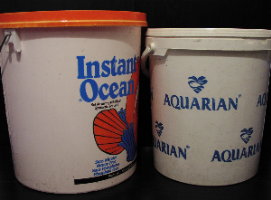|
|
Moving house with aquarium fish
|
Moving house when you have fish tanks adds a whole new level of complication to what can already be a stressful event!
This article provides a few guidelines to help make moving your tanks easier and safer, and minimise the stress to
your fish (and you!). |
| |
|
Preparation
Do not feed the fish for at least 24 hours before moving - 48 hours would probably be better, especially if the journey time will be longer,
or the time taken to set up the tank again will be extended. A day or two without food will not harm any fish, and will minimise wastes in the
transport container, which definitely could harm the fish. This is particularly important for large predatory fish, which may regurgitate
food when stressed, which will rapidly pollute the water.
|
|
Try to obtain plenty of fish bags (a local store might be willing to give you a few, or failing that, at least sell you some cheap). It's also useful
to obtain a polystyrene/styrofoam box to put the bags in. A plastic cooler box would also be suitable. This will provide some physical protection and
help to maintain temperature. An alternative to fish bags is buckets with lids which fasten down tightly. These are particularly suitable for fish
with spiny fins or fish which are likely to bite through bags. Make sure the buckets have not been used with anything potentially toxic, and rinse
them well before use.
|

Buckets with lids can come in very handy for transporting fish! |
|
Whichever you use, you should only fill the bags or buckets about one-third full of tank water. This leaves a good size air gap above the water.
The fish will be fine as long as they have enough water to swim freely in. Water can only hold a certain amount of oxygen, so having an air
gap above the water is vital to allow extra oxygen to dissolve into the water. Pinch fish bags near the top as you close them, so that they contain
as much air as possible - this might take a bit of practice if you're not used to doing it. Use as many bags or buckets as possible to minimise the
number of fish in each one.
|
| |
|
Breaking down and transporting the tank and fish
It will be easier to catch the fish if you first remove the decor from the tank. Decor like bogwood, plastic plants, etc can be
placed in bags or buckets. Keeping it moist will help to preserve some of the bacteria which build up on all solid surfaces in a mature tank.
Live plants should be bagged up in sealed bags with just enough tank water to keep them moist, or wrapped in moist newspaper.
Make sure the heater is switched off at least 10-15 minutes before removing from the tank or draining, so that it has time to cool off. Some heaters
will crack if not allowed to cool first. Depending on the type of filter you have, it will usually be better to remove any 'biomedia' and transport it
separately, keeping it wet in tank water, to help preserve the bacteria.
Always empty the tank completely. Never transport the tank with water or heavy gravel substrate in the bottom. Even if the tank does not physically crack,
the joints may be stressed enough to cause leaks when refilling.
If you have prepared the fish for transport as above, then they should be ok for at least several hours. Natural movement during transport should help to
agitate the water surface and aerate the water. For long journeys or in warmer weather, you might want to consider purchasing a battery-powered air pump.
|
| |
|
Setting up again
Obviously, the sooner the tank and filter are up and running again, the better - so make this a priority. The less time the filter is off, the less
severe the impact will be on the all-important nitrifying bacteria. It may be feasible to run smaller filters in a bucket or other temporary
storage container while the tank is set up.
Fill the tank with conditioned/dechlorinated tap water, leaving room to add any mature water that you have managed to transport.
Treat the fish in the same way you would for newly purchased fish. Float the bags for a while to equalise temperature.
Once everything is up and running, the tank and filter will need a little time to re-stabilise properly. Therefore, keep the feeding a little lighter
than usual. Do not add any new fish for at least a couple of weeks. It would be a good idea to check the water for ammonia and nitrite levels for the
next week or two, to assess whether the bio-filtration was significantly affected.
|
[Home]
[Article Library]
[Fish Index]
[Tank Setups]
[Forum]
[Site Map]
|
|
|



